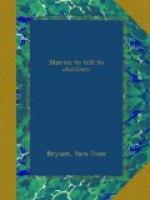I have indicated that the children may be left undisturbed in their crudities and occasional absurdities. The teacher, on the other hand, must avoid, with great judgment, certain absurdities which can easily be initiated by her. The first direful possibility is in the choice of material. It is very desirable that children should not be allowed to dramatise stories of a kind so poetic, so delicate, or so potentially valuable that the material is in danger of losing future beauty to the pupils through its present crude handling. Mother Goose is a hardy old lady, and will not suffer from the grasp of the seven-year-old; and the familiar fables and tales of the “Goldilocks” variety have a firmness of surface which does not let the glamour rub off; but stories in which there is a hint of the beauty just beyond the palpable—or of a dignity suggestive of developed literature—are sorely hurt in their metamorphosis, and should be protected from it. They are for telling only.
Another point on which it is necessary to exercise reserve is in the degree to which any story can be acted. In the justifiable desire to bring a large number of children into the action one must not lose sight of the sanity and propriety of the presentation. For example, one must not make a ridiculous caricature, where a picture, however crude, is the intention. Personally represent only such things as are definitely and dramatically personified in the story. If a natural force, the wind, for example, is represented as talking and acting like a human being in the story, it can be imaged by a person in the play; but if it remains a part of the picture in the story, performing only its natural motions, it is a caricature to enact it as a role. The most powerful instance of a mistake of this kind which I have ever seen will doubtless make my meaning clear. In playing a pretty story about animals and children, some children in an elementary school were made by the teacher to take the part of the sea. In the story, the sea was said to “beat upon the shore,” as a sea would, without doubt. In the play the children were allowed to thump the floor lustily, as a presentation of their watery functions! It was unconscionably funny. Fancy presenting even the crudest image of the mighty sea, surging up on the shore, by a row of infants squatted on the floor and pounding with their fists! Such pitfalls can be avoided by the simple rule of personifying only characters that actually behave like human beings.
A caution which directly concerns the art of story-telling itself, must be added here. There is a definite distinction between the arts of narration and dramatisation which must never be overlooked. Do not, yourself, half tell and half act the story; and do not let the children do it. It is done in very good schools, sometimes, because an enthusiasm for realistic and lively presentation momentarily obscures the faculty of discrimination. A much loved and respected




